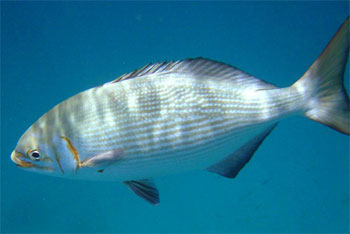Commercial fishing can cause fish population imbalance
Commercial fishing can cause fish population imbalance
mongabay.com
October 18, 2006
New research has found that commercial fishing can cause significant fluctuations in marine fish populations.
Writing in Nature, scientists from several institutions and agencies argue that fishing can amplify the highs and lows of natural population variability.
“We found that the variability of the targeted populations was much higher, meaning that fishing tends to amplify both the peaks and the valleys of population numbers,” said George Sugihara, a co-author of the paper and an oceanographer at the Scripps Institution of Oceanography at the University of California at San Diego. “Fishing can potentially not only lead to declining stock levels, but cause populations to fluctuate more through time, which could put them at greater risk of collapse than previously thought.”

|
The researchers believe that fished populations become more variable due to the removal of larger, older individuals most capable of reproduction, leaving the population vulnerable to natural stresses like El Niño.
“A ton of fish of the very largest sizes has far more value to future populations if preserved than a ton of smaller fish, which contribute far less to reproduction,” said Philip Taylor, director of the National Science Foundation’s Biological Oceanography Program, which provided funding for the research.
Sugihara said the study suggests that fish populations need to be managed not only to maintain the total number of individuals but also to target a certain fish population age structure in the stock. He further warned that such fluctuations could serve as an early warning sign preceding a population crash.
The paper appeared as two studies — one Tuesday from the National Academy of Sciences and another today in the Journal of the American Medical Association — said that the benefits of eating fish twice a week outweigh the risks presented by methyl mercury and other contaminants.
RELATED
Up to 73 million sharks killed per year for their fins
Between 26 million and 73 million sharks are killed each year for their fins according to a new paper published in the October 2006 edition of Ecology Letters. The estimates are three times higher than those projected by the United Nations.
History of the Chilean Sea Bass market
Today The Wall Street Journal ran an account of how the Chilean Sea Bass was first brought to market in 1977. Since its introduction, the species — also known as the Patagonian toothfish — has gone from being shunned to being welcomed at the worst’s finest restaurants. But demand for the fish has taken its toll and the slow-growing species which takes 10-12 years to reach sexual maturity suffers from illegal over fishing in parts of its range. Some groups estimate that the illegal take may be up to five times the legal catch limit, leading some ecologists to predict the immanent collapse of the fishery.
Where are the fish? Ocean fisheries in trouble
Talks began in Canada this week aimed at addressing the deteriorating condition of the world’s marine fisheries, but in an atmosphere with little reason for optimism. Past efforts to manage fisheries or control overfishing have largely failed to slow the depletion of marine resources.







